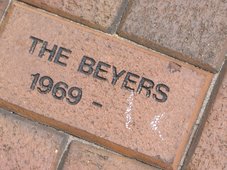Tuesday, February 9, 2010
Clear Snow From Decks/Flat Roofs
We saw this on the River Hill listserv:
* Reduce the Collapse Risks - Residents are encouraged to shovel all flat roofs and decks to prevent the potential for collapse. Most roofs in Howard County have been designed for a live load of 30 lbs. per square foot (PSF), which relates to 57.7” or approximately 60” (5’) of heavy wet snow. 30 PSF is a uniformly distributed live load, not the absolute failure load. It is also a worst-case, conservative estimate.
The biggest concern is blocked primary and/or secondary roof drains, especially on flat roofs. This becomes an even bigger concern as the snow begins to melt, or if we get rain on top of snow. Collapse warning signs:
1. Visibly sagging roofs or ceilings, either inside or outside.
2. Noticeably opening cracks or building joints.
3. ANY moaning, creaking or cracking sounds from the floors, walls, or especially the roof/ceiling.
If you experience a or b LEAVE THE BUILDING, evaluate the roof loading conditions, and if it can be done safely, mitigate the overloading condition(s) (i.e. clear the drains, reduce the drifts). If you experience c, EVACUATE THE BUILDING IMMEDIATELY and Dial 911, then consult with a qualified structural engineer.
Drifting and melting snow can also overload basement foundation walls, causing them to push in and collapse. As the snow starts to melt, general flooding will also be a concern.
(This information has been provided by the Howard County Department of Inspections, Licenses and Permits)
* Reduce the Collapse Risks - Residents are encouraged to shovel all flat roofs and decks to prevent the potential for collapse. Most roofs in Howard County have been designed for a live load of 30 lbs. per square foot (PSF), which relates to 57.7” or approximately 60” (5’) of heavy wet snow. 30 PSF is a uniformly distributed live load, not the absolute failure load. It is also a worst-case, conservative estimate.
The biggest concern is blocked primary and/or secondary roof drains, especially on flat roofs. This becomes an even bigger concern as the snow begins to melt, or if we get rain on top of snow. Collapse warning signs:
1. Visibly sagging roofs or ceilings, either inside or outside.
2. Noticeably opening cracks or building joints.
3. ANY moaning, creaking or cracking sounds from the floors, walls, or especially the roof/ceiling.
If you experience a or b LEAVE THE BUILDING, evaluate the roof loading conditions, and if it can be done safely, mitigate the overloading condition(s) (i.e. clear the drains, reduce the drifts). If you experience c, EVACUATE THE BUILDING IMMEDIATELY and Dial 911, then consult with a qualified structural engineer.
Drifting and melting snow can also overload basement foundation walls, causing them to push in and collapse. As the snow starts to melt, general flooding will also be a concern.
(This information has been provided by the Howard County Department of Inspections, Licenses and Permits)
Subscribe to:
Post Comments (Atom)





1 comment:
Click here to read a story about a Prince George's County resident that may have caused a roof collapse through the process of clearing snow off of his roof. The article contains a recommendation to hire a professional roof contractor to clear off your roof, although I doubt many people would follow that advice.
Post a Comment